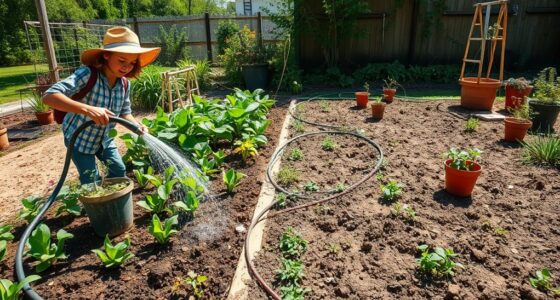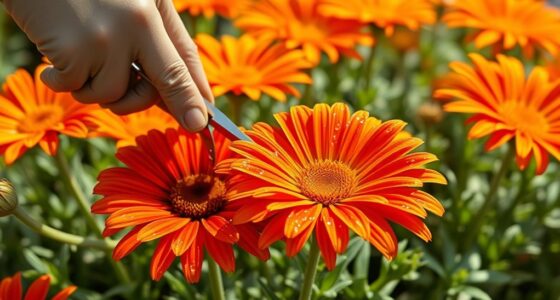Avoid skipping soil preparation, as healthy, nutrient-rich, and well-draining soil is essential to strong plants. Don’t wait too long to control pests; early action prevents widespread damage. Make sure to understand each plant’s specific needs for sunlight, water, and nutrients to prevent weak growth. Timing is vital—plant at the right season to give your garden the best start. Also, be cautious with water and fertilizer; overdoing it can do more harm than good. Keep these tips in mind to improve your gardening success.
Key Takeaways
- Skipping soil assessment and improper preparation can lead to weak roots and poor plant growth.
- Ignoring pest early signs allows infestations to spread and cause significant damage.
- Not understanding specific plant needs may result in weak, unhealthy plants or death.
- Planting at the wrong time or season increases vulnerability to weather and pests.
- Overwatering or over-fertilizing weakens plants and attracts pests, harming overall garden health.

Gardening can be incredibly rewarding, but even experienced gardeners make mistakes that can hinder their plants’ growth. One common error beginners often make is neglecting proper soil preparation. Healthy plants start with good soil, so skipping this step can lead to weak roots and poor growth. Before planting, you should assess your soil’s quality, ensuring it’s well-draining and rich in nutrients. Incorporate organic matter like compost or aged manure to improve fertility and structure. Testing your soil’s pH level is also essential, as different plants thrive in specific pH ranges. Failing to prepare the soil properly can make your plants more susceptible to pests and diseases, ultimately stunting their development.
Healthy soil is the foundation for thriving plants; don’t skip soil prep.
Another mistake many beginners make is overlooking pest management. Instead of proactively preventing pests, they often wait until they see damage, which can be too late. Pests can quickly spread and destroy your plants if not managed early. It’s important to implement integrated pest management strategies, such as introducing beneficial insects like ladybugs or using natural repellents. Regularly inspecting your plants helps you catch infestations early, minimizing the need for chemical interventions. Also, keeping your garden tidy by removing fallen leaves and debris reduces hiding spots for pests. Neglecting pest management can lead to significant setbacks, so staying vigilant from the outset is key.
Many newcomers also underestimate the importance of learning about their specific plants’ needs. Different plants require varying amounts of sunlight, water, and nutrients. Failing to match plants to their ideal conditions can result in weak growth or even death. Take time to research the particular varieties you’re growing, and adjust your watering schedule accordingly. Overwatering can cause root rot, while underwatering stunts growth; striking the right balance is essential. Moreover, understanding the fundamentals of soil health can help you create a more resilient garden environment.
Timing is another critical factor that beginners often overlook. Planting too early or too late in the season can leave your plants vulnerable to weather changes or pests. Pay attention to your local planting calendar, and don’t rush the process. Proper timing ensures your plants establish well and are better equipped to resist pests and diseases.
Lastly, many new gardeners assume that more water or fertilizer will speed up growth, but this can backfire. Excess nutrients can weaken plants and attract pests. Use fertilizers sparingly, following recommended guidelines, and always monitor your plants’ response. Consistent, moderate care is more effective than overdoing it. Avoiding these common mistakes—focusing on soil preparation, pest management, and understanding your plants’ needs—sets a solid foundation for a thriving, healthy garden.
Frequently Asked Questions
How Can I Prevent Overwatering My Plants?
To prevent overwatering your plants, follow watering tips like checking soil moisture before watering and avoiding frequent, shallow watering. Use drainage solutions such as well-draining pots and soil to prevent water from sitting around roots. Water deeply but infrequently, allowing the soil to dry out slightly between watering sessions. This approach keeps roots healthy and prevents root rot, ensuring your plants thrive without the risk of overwatering.
What Are the Best Beginner-Friendly Plants to Start With?
When choosing beginner-friendly plants, consider ones that thrive with minimal fuss, like succulents or pothos. Plan your garden layout to give each plant enough space and light. It’s also vital to set a consistent watering schedule tailored to each plant’s needs. These simple steps help you create a thriving garden, making your gardening journey enjoyable and stress-free from the start.
How Do I Choose the Right Soil for My Garden?
When choosing the right soil for your garden, start with soil testing to understand its nutrient levels and pH. This helps you identify what amendments are needed. Opt for organic amendments like compost or aged manure to improve soil health naturally. Avoid heavy clay or sandy soils that drain poorly. By testing your soil and adding organic amendments, you create a nutrient-rich environment that promotes healthy plant growth.
When Is the Ideal Time to Plant Different Vegetables?
Think of planting vegetables like tuning an instrument; timing is everything. You should follow a vegetable calendar and consider seasonal planting guidelines. For instance, tomatoes thrive when planted after the last frost, usually late spring. Early spring is perfect for lettuce and peas. By paying attention to your local climate and seasonal cues, you’ll guarantee your vegetables grow strong and healthy, just like a perfectly tuned instrument.
How Can I Protect Plants From Pests Naturally?
You can protect your plants naturally by encouraging beneficial insects like ladybugs and lacewings, which prey on pests. You should also practice companion planting, pairing plants that repel pests with those that attract beneficial insects. Avoid chemical pesticides, as they harm helpful bugs and disrupt your garden’s balance. Instead, create a diverse environment that naturally keeps pests at bay, ensuring healthier, more resilient plants.
Conclusion
By steering clear of these common mistakes, you’ll nurture your garden like a skilled captain guiding a ship through calm waters. Remember, gardening isn’t about perfection but patience and learning along the way. Every error is a wave to ride, helping you grow more confident and successful. Keep your enthusiasm steady, stay curious, and your garden will flourish, turning your outdoor space into a vibrant, thriving oasis. Happy gardening—your green thumb is just waiting to bloom!









